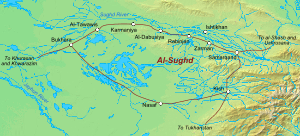Rabinjan

Rabinjan or Arbinjan (Arabic: ربنجن، أربنجن) was a medieval town in the region of Transoxiana, between the cities of Samarkand and Bukhara. It was located in the vicinity of the present-day Katta-Kurgan.[1]
Geography
The Muslim geographers described Rabinjan as a town of Sughd and a dependency of Samarkand. It was one of the settlements on the Samarkand-Bukhara road, lying between Zarman to the east and al-Dabusiya to the west,[2] and was located to the south of the Sughd River.[3] Ibn Khurradadhbih described the town as being twelve farsakhs from Samarkand and twenty-seven from Bukhara;[4] Qudama, on the other hand, considered it to be thirteen farsakhs from Samarkand and twenty-four from Bukhara.[5] Al-Istakhri added that it was two farsakhs from al-Kushaniya.[6]
History
The site of Rabinjan was settled almost two thousand years ago.[7] In the pre-Islamic history of the town, it was considered as one of the settlements of Sogdiana. During this period there may have been a Christian presence in the town, as evidenced by a ceramic cast for molding crosses which was recovered from the area.[8]
During the Muslim conquest of Transoxiana, Rabinjan was subjected to attacks by the Arabs. In 699 Habib ibn al-Muhallab undertook a raid against it, but he was opposed by an army led by the lord of Bukhara and decided to withdraw.[9] It was during the campaigns of Qutayba ibn Muslim (705–715) that Rabinjan was conquered by the Muslims. In 712 the town was the scene of a skirmish between the armies of Qutayba and Ghurak, the Sogdian prince of Samarkand; the Muslims won the engagement and they were able to continue their advance to Samarkand.[10]
After its conquest, Rabinjan shared the history of Muslim Sughd, and it was ruled successively by the Umayyads, Abbasids and Samanids.[11] In the ninth and tenth centuries it was generally included by the Muslim geographers in their accounts of Transoxiana. Al-Muqaddasi, writing in the late tenth century, recorded that Rabinjan produced a number of goods, including winter shawls, dried dates, metal drinking cups, ropes made of hemp, and sulfur.[12] Other writers noted that it was also known for its saddlecloths[13] and production of tin bronze.
Following the downfall of the Samanids in the late eleventh century, Rabinjan became a possession of the western Qarakhanids. In 1158 the town was destroyed during the Khwarazm-Shah Il-Arslan's invasion of Transoxiana.[14]
Notes
- ↑ Barthold, p. 97; Buryakov et al, p. 43
- ↑ Ibn Khurradadhbih, p. 26; al-Istakhri, pp. 316, 320, 323, 334, 343; Ibn Hawqal, pp. 365, 370, 375, 398, 403; al-Muqaddasi, pp. 47, 222, 278; al-Hamadhani, p. 325
- ↑ Le Strange, p. 468
- ↑ Ibn Khurradadhbih, pp. 25-6
- ↑ Qudama, p. 203
- ↑ Al-Istakhri, p. 343
- ↑ Buryakov et al, p. 43
- ↑ Savchenko and Dickens, p. 299
- ↑ Al-Tabari, v. 22: p. 189; Gibb, p. 25
- ↑ Al-Tabari, v. 23: p. 197; Gibb, p. 45
- ↑ Al-Tabari, v. 24: p. 178; v. 25: p. 85; Narshakhi, pp. 80, 85
- ↑ Al-Muqaddasi, p. 264
- ↑ Al-Tabari, v. 23: p. 197
- ↑ Barthold, p. 97; Abu al-Fida, p. 220
References
- Abu al-Fida, Isma'il ibn 'Ali. Mukhtasar Ta'rikh al-Bashar. Trans M. Stanislas Guyard. Paris: L'Imprimerie Nationale, 1883.
- Barthold, W. Turkestan Down to the Mongol Invasion. Trans. V. Minorskey. Taipei: Southern Materials Center, 1988.
- Buryakov, Y.F., K.M Baipakov, K.H. Tashbaeva, and Y. Takubov. The Cities and Routes of the Great Silk Road: On Central Asian Documents. Tashkent: Sharg, 1999.
- Gibb, H.A.R. The Arab Conquests in Central Asia. London: The Royal Asiatic Society, 1923.
- Ibn al-Faqih, Abu Bakr Ahmad ibn Muhammad al-Hamadhani. Mukhtasar Kitab al-Buldan. Ed. M.J. de Goeje. Leiden: E.J. Brill, 1885.
- Ibn Hawqal, Abu al-Qasim Muhammad. Kitab Surat al-Ardh. Ed. M.J. de Goeje. Leiden: E.J. Brill, 1873.
- Ibn Khurradadhbih, Abu al-Qasim 'Abd Allah. Kitab al-Masalik wa'l-Mamalik. Ed and trans. M.J. de Goeje. Leiden: E.J. Brill, 1889.
- Al-Istakhri, Abu Ishaq al-Farisi. Kitab al-Masalik wa'l-Mamalik. Ed. M.J. de Goeje. 2nd ed. Leiden: E.J. Brill, 1927.
- Le Strange, Guy. The Lands of the Eastern Caliphate: Mesopotamia, Persia, and Central Asia, from the Moslem conquest to the time of Timur. Cambridge: Cambridge University Press, 1905.
- Al-Muqaddasi, Muhammad ibn Ahmad. The Best Divisions for Knowledge of the Regions. Trans. Basil Collins. Reading: Garner Publishing Limited, 2001. ISBN 1-85964-136-9
- Narshakhi, Abu Bakr Muhammad. Tarikh-i Bukhara. Trans. R.N. Frye, The History of Bukhara. Cambridge, MA: Mediaeval Academy of America, 1954.
- Qudama ibn Ja'far. Kitab al-Kharaj. Ed. and trans. M.J. de Goeje. Leiden: E.J. Brill, 1889.
- Savchenko, Alexei, and Mark Dickens. "Prester John's Realm: New Light on Christianity Between Merv and Turfan." The Christian Heritage of Iraq: Collected Papers from the Christianity of Iraq I-V Seminar Days. Ed. Erica C.D. Hunter. Piscataway: Gorgias Press, 2009. ISBN 1607241110
- Al-Tabari, Abu Ja'far Muhammad ibn Jarir. The History of al-Tabari. Ed. Ehsan Yar-Shater. 40 vols. Albany, NY: State University of New York Press, 1985-2007.